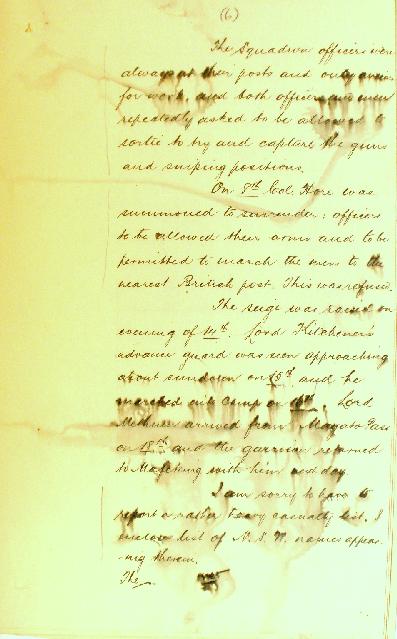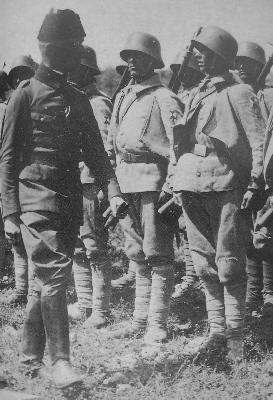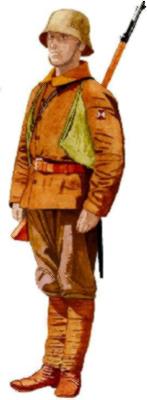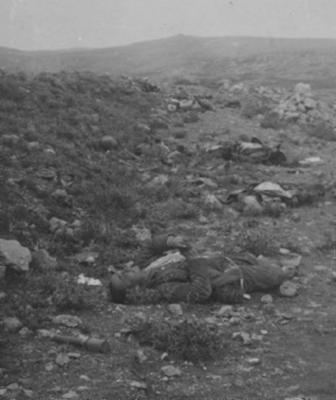Topic: AIF - DMC - BWI
British West Indian Regiment
Contents
Items
British West Indian Regiment
Further Reading
Citation: British West Indian Regiment, Contents

| « | July 2009 | » | ||||
| S | M | T | W | T | F | S |
| 1 | 2 | 3 | 4 | |||
| 5 | 6 | 7 | 8 | 9 | 10 | 11 |
| 12 | 13 | 14 | 15 | 16 | 17 | 18 |
| 19 | 20 | 21 | 22 | 23 | 24 | 25 |
| 26 | 27 | 28 | 29 | 30 | 31 | |

Biographical Research Links
1. First World War Embarkation Roll - AWM
2. First World War Nominal Roll - AWM
3. The AIF Project - ADFA - WW1 Search
4. National Archives Search
5. Boer War Nominal Roll - AWM
6. Australians in the Boer War - Oz-Boer Database Project
7. Archives NZ - Archway
8. Auckland Cenotaph
9. Geoffs British Soldier 1914-1921 Search Engine
10. British Soldier Search - British National Archives
11. London Gazette
12. CEF Search
13. Commonwealth War Graves Commission
14. Les morts pour la France de la guerre
15. Sehitlerimiz
16. Belgian Doden Register
16. Opfer Krieg Gewalt Datenbank Soldatenliste Suche
17. American Battle Monuments Commission
Fora
1. Desert Column Forum
2. British Medals Forum
3. Great War Forum
4. Axis History Forum
5. Victorian Wars Forum
6. NEW ZEALAND MOUNTED RIFLES ASSOCIATION
7. Ships Nostalgia
8. The Aerodrome
9. Austro-Hungarian Land Forces Discussion Forum
10. FORUM pages 14-18
11. Society of the Military Horse
12. Militärbezogene Familiengeschichtsforschung
|
|
|
|
|
|
|
|
|
|
|
|
"At a mile distant their thousand hooves were stuttering thunder, coming at a rate that frightened a man - they were an awe inspiring sight, galloping through the red haze - knee to knee and horse to horse - the dying sun glinting on bayonet points..." Trooper Ion Idriess
The Australian Light Horse Studies Centre aims to present an accurate history as chroniclers of early Australian military developments from 1899 to 1920.
The Australian Light Horse Studies Centre site holds over 12,000 entries and is growing daily.
Contact: Australian Light Horse Studies Centre
Let us hear your story:
You can tell your story, make a comment or ask for help on our Australian Light Horse Studies Centre Forum called:
WARNING: This site contains: names, information and images of deceased people; and, language which may be considered inappropriate today. Desert Column Forum
British West Indian Regiment
Contents
Items
British West Indian Regiment
Further Reading
Citation: British West Indian Regiment, Contents
Miscellaneous Topics
Contents
Items
Army Post Office delivering the mail
British West Indian Regiment
Bugle Calls
Entertainment for the troops - the movies
Events effecting soldier's pay and pay book
Happy New Year for 2009
Light Horsemen who enlisted in 1914 and served over 5 years
Merry Christmas, 2008
Pip, Squeak and Wilfred - the Trio Medals
Sand Cart Plans and Description
Three Cadets from Royal Military College
Troop transport ships
William De Passey
Further Reading
Australian Light Horse Militia
Citation: Miscellaneous Topics, Contents
Western Australian Militia
York Infantry
The following is an extract from the book written in 1962 by George F. Wieck called The Volunteer Movement in Western Australia 1861-1903, p. 55:
York Infantry
The York Infantry was gazetted on 20 February 1899 as a Volunteer corps and given an Establishment of 60 all ranks. Lieutenant W. D. Cowan was appointed to Command and was promoted to the rank of Captain as from 20 August 1898. For all practical purposes this corps was the old "York Infantry Volunteers" under a new name, the only noticeable difference being a reduction of the Establishment by 10 other ranks. Continuity was not broken.
When the W.A. Infantry Brigade was formed in 1900, the York Infantry became "D" Company of the 3rd Battalion thereof, with Captain W. D. Cowan Commanding the Battalion.
Disbandment of the York Infantry was ordered as from 27 March 1902, no specific reason being given.
Officers of the York InfantryCaptain WD Cowan, 20 August 1898
Previous: Perth Mounted Rifle Volunteers
Next: 1st Infantry Regiment
Further Reading:
Western Australian Militia, Light Horse
Western Australian Militia, Infantry
The Battle of Elands River, 4 August 1900
Report by Major Tunbridge, 15 September 1900, Page 6

Report by Major Tunbridge about Elands River, 15 September 1900, page 6.
On 15 September 1900, Major Tunbridge wrote a report of the action at Elands River for the NSW General Staff of which page 6 is transcribed below.
6)
The Squadron officers were always at their posts and only anxious for work, and both officers and men repeatedly asked to be allowed to sortie to try and capture the guns and sniping positions.
On 8th Colonel Hore was summoned to surrender; officers to be allowed their arms and to be permitted to march the men to the nearest British post. This was refused.
The siege was raised on evening of 14th. Lord Kitchener's advance guard was seen approaching about sundown on 15th and he marched into camp on 16th. Lord Methuen arrived from Magato Pass on 18th and the garrison returned to Mafeking with him next day.
I am sorry to have to report a rather heavy casualty list. I enclose list of NSW names appearing therein.
Previous: Report page 5
Next: Report page 7
Further Reading:
Battles where Australians fought, 1899-1920
Turkish Army
Hücüm Müfrezesi - Storm Troopers


Kress inspecting Ottoman Storm Troopers, late 1917.
The following account of the Storm Troopers in the Ottoman Army is extracted from the book written by Ed Erickson called Ottoman Army effectiveness in World War I: a comparative study, Oxford, 2007, and taken from pp. 103-5:
Tactical innovations from the western front were also introduced on a routine basis in Palestine. On 25 October 1917, German Colonel Hergote, fresh from the western front, delivered a presentation to the 21st Infantry Regiment on the principles of assault and battle training, and also on reconnaissance training.
The 7th Infantry Division was simultaneously engaged in a major restructuring of its tactical organisational architecture. After its arrival in Beersheba, the division inactivated the 4th Company of each infantry battalion on 28 June. On 10 August reflecting the most current tactical thinking, the division activated a machine-gun company, armed with light machine guns, in every infantry battalion.' This reorganisation was repeated in every Ottoman infantry division in Palestine. Thus as the 7th Infantry Division lost a quarter of its rifle strength it gained offensive and defensive capability by the addition of light machine guns within infantry battalions.`"
On 17 July 1917, the division activated an assault detachment (hücüm müfrezesi) of fifty men. (This was the Turkish version of German Stosstruppen.) This was a local initiative implemented by von Kressenstein, who wanted to introduce the most current western front tactical innovations into his army. He assigned Major Kiehl to supervise the training of the Ottoman assault troops 'with good results' . Kress inspected the companies in September 1917 and mentioned, `it is evident that proper training and grooming would bring out the best in these brave, obedient, and humble Anatolian soldiers' . In the absence of written doctrinal information, an unofficial manual on assault troop tactics was written and distributed by the 19th Infantry Division commander, which was based on the experiences of that division in Galicia.
The fact that the Ottoman Army raised, trained, equipped, and employed stone troops has escaped general notice in the English language historiography of World War 1. However, in 1994, Dr. David Nicolle published a clear photograph of a platoon of Ottoman Army storm troops in Palestine in the summer of 1918. The men are outfitted in well fitting uniforms, German-style steel helmets, have under-arm grenade bags with stick grenades, German Mauser rifles, and puttee leggings. This unique photograph is important because the men look confident and fit, well fed, and arc thoroughly equipped - indeed, a picture that is at odds with our historical perception of the Ottoman Army in Palestine. Although it is dangerous to draw a generalised conclusion from Nicolle's photograph, it is obvious that the Turks, at least in one locality, gave a high priority to the selection of men for, and to the maintenance of, its assault troop formations.
On I September 1917, Enver Pasha ordered the general activation of assault troops within the Ottoman Army. Enver directed the XV Corps, the First Army, and the Fourth Army to activate the 1st, 2nd, and 3rd Assault Battalions respectively. Additionally, he ordered each infantry division in the Yildirim Army Group and in the Fourth Army to activate assault detachments. Enver was very specific that only the best officers, NCOs, and men (`from the best units in the division, who were intelligent, healthy and hardy, and not more than twentyseven years of age') were selected for these elite units. Additionally, the assault units received better rations, a distinctive badge (an embroidered hand grenade), and conducted a one-month assault course. Later the divisional assault detachments matured into assault battalions. Initially, the Ottoman armies in Mesopotamia, western Anatolia, and Caucasia were excluded from the requirement to activate assault troops.
In the creation of assault battalions the Ottoman Army returned to an organisational architecture that it had abandoned in 1913. One of the Ottoman General Staff's organisational changes in 1914 was the abolition of the organic rifle regiment at army corps level and the organic rifle battalion at infantry division level. These highly specialised regiments and battalions were the Ottoman Army's equivalent of German Jäger or French chusseurs. The reason for this action was the inability of the army during the Balkan Wars to utilise effectively the rifle regiments and battalions in their proper doctrinal role. In fact, during the First Balkan War, Ottoman commanders tended to misuse their rifle battalions as immediate reserves or as a nucleus for ad hoc provisional formations. They were almost never used properly in reconnaissance, screening, or flank guard missions. Consequently, the Ottoman General Staff deactivated the rifle units in the spring of 1914 because the misuse of concentrations of hand-picked men degraded the overall quality of the regular infantry regiments. It should be noted that after World War 2 the US Army deactivated its Ranger battalions for the same reason - the concentration of elite soldiers in specialised units weakened the army's regular infantry establishment and there did not seem to be an appropriate tactical return on such an investment.
The activation of the assault battalion (hücüm tahur) essentially returned the Ottoman Army to the elitist organisational architecture of 1910-14. Each infantry division had three infantry regiments (of three infantry battalions) and one assault battalion, within which there was a high concentration of aggressive and fit officers and men. Unlike the German Army, the Turks formed no specialised assault or storm troop divisions.
By the end of 1917 the strategic and operational initiative in Palestine had passed to the British. Consequently, both the practical and technical need of the Ottoman Army to possess assault troops also passed. Nevertheless, the assault troop battalions of the Ottoman Fourth, Seventh, and Eighth Armies were retained, possibly with a view to future offensive operations of the Yildirim Army Group. It should be remembered that until the failure of the Ludendorff offensives in the spring of 1918, the strategic posture of the Central Powers appeared favourable.

With the falling moral of the Ottoman Army during the first half of 1918, the elite units also suffered a decline. A secret memo detailing the state of the Yildirim Army Group in July 1918 states the following:
Attack UnitsVIIth Army Attack Battalion.This battalion is camped about two miles south of Narblus. All men are equipped with steel helmets and gas masks. At present it is used in arresting deserters, but in case of the British advance it is to be used to counter attack.XX Army Corps Attack Battalion.This battalion is in reserve in the XXth Army Corps area. Its strength and equipment are similar to those of the VIIth Army Battalion.20th Division Attack CompanyThis company is camped near Jalud (C.5/O.2.a.) and is 130 strong. It formerly numbered 180, but three weeks ago, 50 men deserted, taking with them two machine guns stolen from a Regimental Machine Gun Company. (Officer deserter, 4/78th Regiment, 10-9).
Comment -The above strengths are greater than in the case of other formations and are probably exaggerated.
Further Reading
The Battle of El Burj, 1 December 1917
Citation: Turkish Army, Hücüm Müfrezesi - Storm Troopers
The Australian Light Horse Studies Centre is a not for profit and non profit group whose sole aim is to write the early history of the Australian Light Horse from 1900 - 1920. It is privately funded and the information is provided by the individuals within the group and while permission for the use of the material has been given for this site for these items by various donors, the residual and actual copyright for these items, should there be any, resides exclusively with the donors. The information on this site is freely available for private research use only and if used as such, should be appropriately acknowledged. To assist in this process, each item has a citation attached at the bottom for referencing purposes.
Please Note: No express or implied permission is given for commercial use of the information contained within this site.
A note to copyright holders
The Australian Light Horse Studies Centre has made every endeavour to contact copyright holders of material digitised for this blog and website and where appropriate, permission is still being sought for these items. Where replies were not received, or where the copyright owner has not been able to be traced, or where the permission is still being sought, the Australian Light Horse Studies Centre has decided, in good faith, to proceed with digitisation and publication. Australian Light Horse Studies Centre would be happy to hear from copyright owners at any time to discuss usage of this item.
Contact